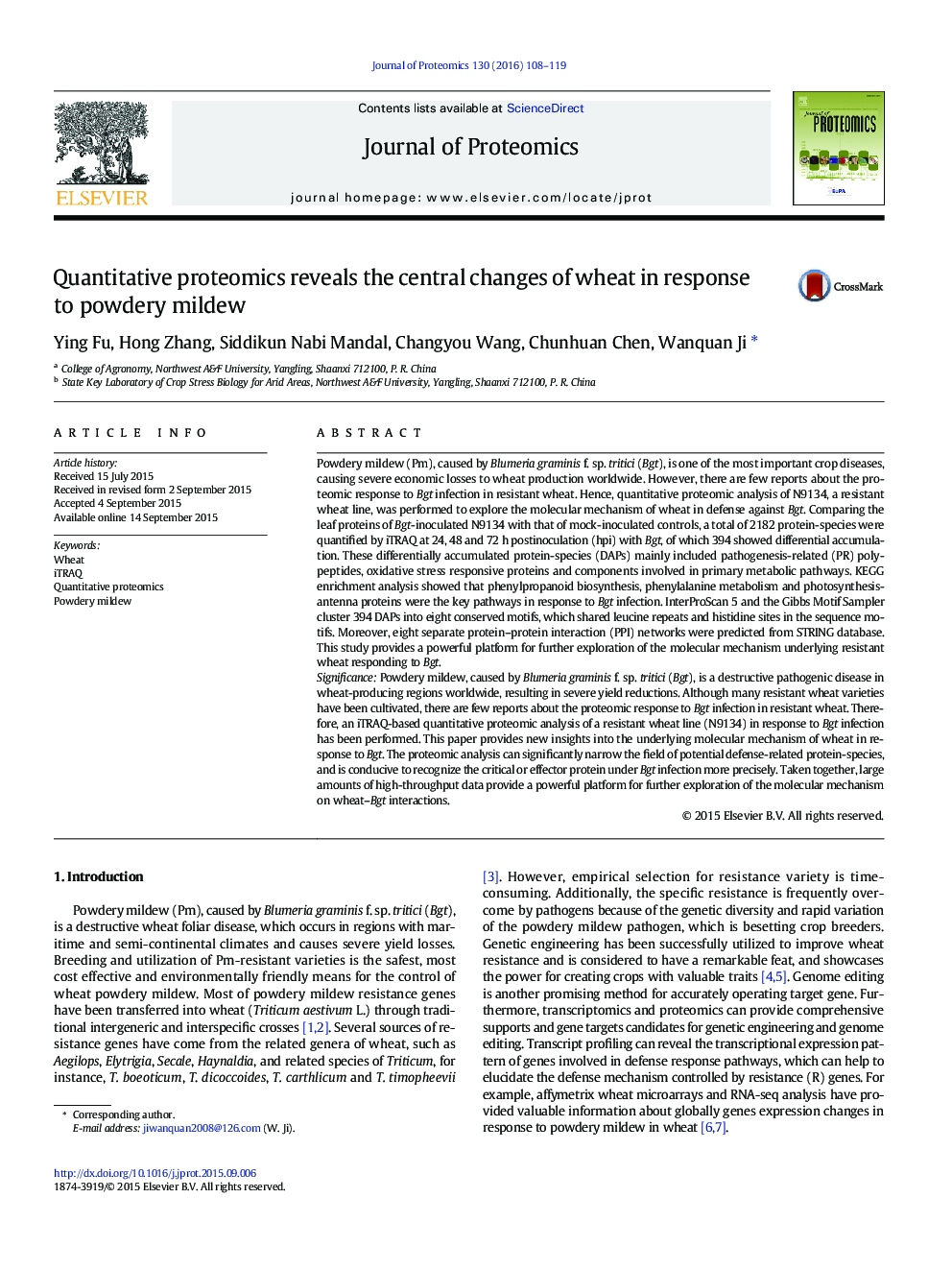| کد مقاله | کد نشریه | سال انتشار | مقاله انگلیسی | نسخه تمام متن |
|---|---|---|---|---|
| 1225880 | 1494751 | 2016 | 12 صفحه PDF | دانلود رایگان |
• Quantitative proteomic analysis of resistant wheat in response to powdery mildew.
• The 394 differentially accumulated protein-species involved in plant defense pathways.
• Three key KEGG pathways in response to powdery mildew were significantly enriched.
• The eight conserved motifs shared leucine repeats and histidine site in the sequence.
• The study provides an understanding of the defense mechanisms of resistant wheat.
Powdery mildew (Pm), caused by Blumeria graminis f. sp. tritici (Bgt), is one of the most important crop diseases, causing severe economic losses to wheat production worldwide. However, there are few reports about the proteomic response to Bgt infection in resistant wheat. Hence, quantitative proteomic analysis of N9134, a resistant wheat line, was performed to explore the molecular mechanism of wheat in defense against Bgt. Comparing the leaf proteins of Bgt-inoculated N9134 with that of mock-inoculated controls, a total of 2182 protein-species were quantified by iTRAQ at 24, 48 and 72 h postinoculation (hpi) with Bgt, of which 394 showed differential accumulation. These differentially accumulated protein-species (DAPs) mainly included pathogenesis-related (PR) polypeptides, oxidative stress responsive proteins and components involved in primary metabolic pathways. KEGG enrichment analysis showed that phenylpropanoid biosynthesis, phenylalanine metabolism and photosynthesis-antenna proteins were the key pathways in response to Bgt infection. InterProScan 5 and the Gibbs Motif Sampler cluster 394 DAPs into eight conserved motifs, which shared leucine repeats and histidine sites in the sequence motifs. Moreover, eight separate protein–protein interaction (PPI) networks were predicted from STRING database. This study provides a powerful platform for further exploration of the molecular mechanism underlying resistant wheat responding to Bgt.SignificancePowdery mildew, caused by Blumeria graminis f. sp. tritici (Bgt), is a destructive pathogenic disease in wheat-producing regions worldwide, resulting in severe yield reductions. Although many resistant wheat varieties have been cultivated, there are few reports about the proteomic response to Bgt infection in resistant wheat. Therefore, an iTRAQ-based quantitative proteomic analysis of a resistant wheat line (N9134) in response to Bgt infection has been performed. This paper provides new insights into the underlying molecular mechanism of wheat in response to Bgt. The proteomic analysis can significantly narrow the field of potential defense-related protein-species, and is conducive to recognize the critical or effector protein under Bgt infection more precisely. Taken together, large amounts of high-throughput data provide a powerful platform for further exploration of the molecular mechanism on wheat–Bgt interactions.
Figure optionsDownload high-quality image (193 K)Download as PowerPoint slide
Journal: Journal of Proteomics - Volume 130, 1 January 2016, Pages 108–119
